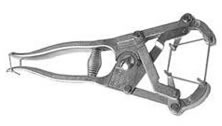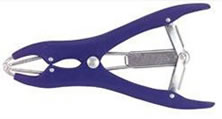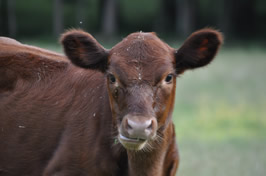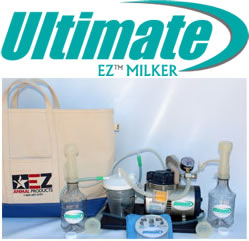by Gabriella Nanci

Castrator I3 - C1

Castrator IA - M1

EZE Bloodless Castrator Model T1
When I started out with cattle, I was taught that the proper way to castrate was to use an emasculator and a scalpel. But again, I have found that there is a simpler way to castrate calves and adult bulls that is more humane and effective.
Band Castration for Young Calves: Band castration is easy and affordable, and the animals do not get that “under the weather” look like they do after surgical castration. There is much less risk of fly problems and no blood loss, (since there is no open wound). There are basically two types of band elasticator, a wide bodied one like Jeffers’ Band Castrator, Item number I3-C1, and a narrow bodied one like Jeffers® Band Castrating Tool, Item number IA-M1 from Jeffers Livestock. The wider model runs about 19.00 and theoretically stretches the band a little wider than other models. It has a little latch to keep it open while you place the band over the testicles, which may come in handy for lambs, since they have bigger testicles than calves. However, I like the narrower bodied banders much better for Dexter calves and they only cost about 9.00. It is easier to fit between the calves back legs. Plus my technique for banding very young calves doesn’t utilize the latch to keep it open. I usually put the band on the scrotal sack and release it. (At that point you pretty much have an empty sack.) Then I fish for the testicles one at a time, push them into the sack, keeping them in the sac by opening the bander just enough to push each testicle, one at a time, past the band (and into the sac).
This is all done, of course, through the skin. I have banded hundreds of calves and lambs this way, and have never found out later that I “missed” a testicle. (Fear of missing a testicle is one of the reasons people turn to surgical castration; it’s easy to know you have both, if they are in a bucket.) The bands for these elasticators are “universal” and cost about 5 cents a piece. We also give them a tetanus shot at same time.
Band Castration for Adult Bulls: I started banding young calves long ago, but the older ones still had to be cut because they were simply too big to band. Then, I read an article comparing weight gain in steers to the timing and method of castration. Steers gained better when castrated later, and they did not lose weight when they were banded, as they did when they were cut. Now if the animal did not lose weight from the castration, that means it wasn’t as traumatic, right? That looked like a win-win situation to me. And, the article brought to my attention that adult banding was possible. I purchased a $170 dollar gadget that bands adult cattle. The model I purchased is the EZE Bloodless Castrator Model T1, item number WD-D1 at Jeffers Livestock and it comes with a video and instruction booklet. (There is a little note on there about removing the band from the spreader bar before tightening the band. I had to break several bands at $1 a piece before I realized what the note meant; so pay attention!) I was amazed that the animals seem to hardly notice the band is on there, and they do not get that droopy-eyed look that their less fortunate surgically-cut friends get. I have even used it on adult rams. You do give them a tetanus shot, as you would with any castration. Late castration allows people to be more selective about what animal gets to be a bull, and this could be a good thing for the breed.
There is also a more affordable, and less cumbersome adult bander on the market for about $55.00. It is called the California Bander from Inosol Co. LLC, 1774 Citrus Ln. El Centr, CA. 92243 (760) 337-9244 or 1-800-847-2533. The Insol website has more information. I have not used this design, but the price is right and it looks quite a bit simpler than mine. If anyone has used this model, please write a little review so we can post it on this site.


